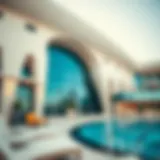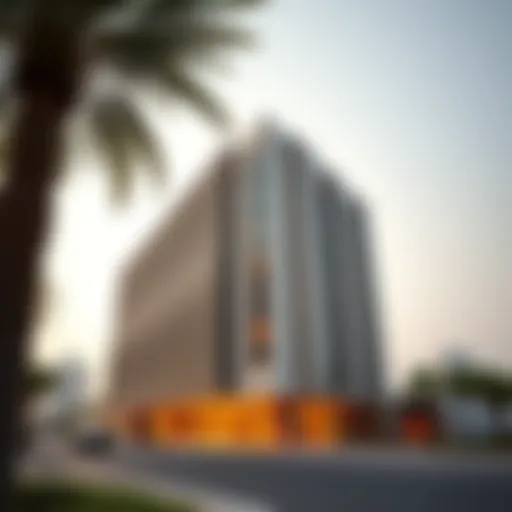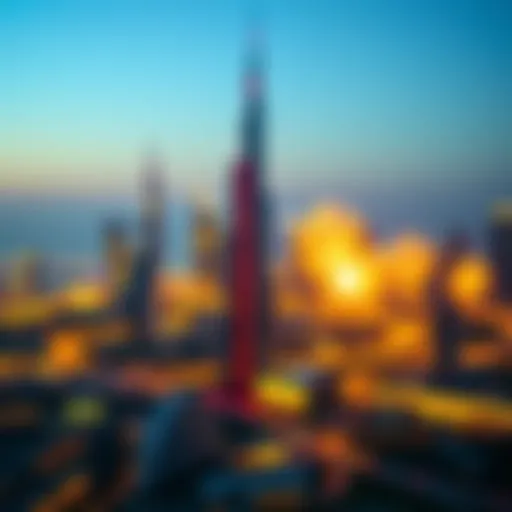Exploring the Gardens of Sheikh Mohammed bin Rashid
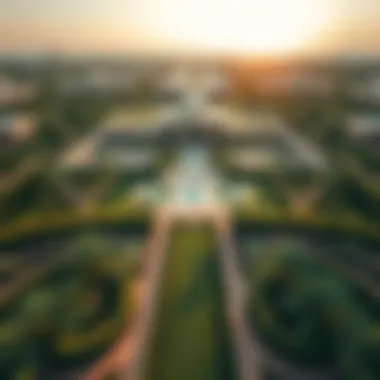

Intro
The Gardens of Sheikh Mohammed bin Rashid stand as a vibrant testament to the merging of nature and urban life in Dubai. These gardens are more than just patches of greenery; they are intricate landscapes that interweave the city's bustling pace with a serene retreat for its residents and visitors. They epitomize a vision where lush flora influences the urban environment. In a city renowned for its skyscrapers and opulence, these gardens offer a refreshing balance, all while presenting a case study of significant cultural and ecological relevance.
By showcasing these gardens, we delve into their historical backdrop, innovative design principles, and the crucial role they play in shaping Dubai's identity. The ambitions of a modern city are palpably reflected within these serene spaces, inviting conversations around sustainability and community enrichment.
Furthermore, as we explore this topic, we aim to present insightful analysis, providing an understanding that resonates. For those looking to invest or simply explore, there's a rich tapestry of opportunities and benefits hidden within the flora and fauna of these gardens. In the subsequent sections, we will delineate current trends, investment potentials, and what role these gardens might play in the larger picture of urban development.
Market Trends and Analysis
Current Market Overview
Dubai's property market has felt the pulse of its real estate ecosystem shaping how green spaces, including gardens, fit into residential plans. The Gardens of Sheikh Mohammed bin Rashid contribute significantly to the locale's appeal, making it an attractive proposition for investors and homeowners alike. As city planning continues to embrace sustainable principles, this particular garden stands at the forefront of cultivating a lifestyle where green meets urban.
Market statistics hint a persistent demand for properties that offer proximity to such green spaces. The lush gardens are drawing attention not only for their aesthetic value but also for the added lifestyle benefits they provide, such as recreational spaces and environmental aesthetics.
Future Market Predictions
Future forecasts indicate a growing trend towards green developments. With Dubai investing heavily in infrastructure that incorporates green areas, the Gardens of Sheikh Mohammed bin Rashid are poised to increase in popularity.
- Increased Property Values: Properties near significant green landmarks often see better returns. The gardens are likely to boost local property values as interest swells.
- Enhanced Community Appeal: As residents increasingly seek a balance between urban living and nature, communities featuring gardens may see a surge in demand, leading to faster growth in those neighborhoods.
- New Projects: Upcoming urban development plans are prioritizing parks and gardens, integrating them into residential and commercial designs to create holistic living areas.
"Gardens are not just spaces for plants; they are practical investments that frame our urban lifestyle--adding both value and vibrancy to our environments."
It's clear that the Gardens of Sheikh Mohammed bin Rashid are more than mere landscaping; they are core elements influencing the future landscape of Dubai, appealing directly to both locals and expatriates seeking a taste of nature amidst the urban bustle.
Prolusion to Sheikh Mohammed bin Rashid Gardens
Sheikh Mohammed bin Rashid Gardens stand as a testament to the ambition and forward-thinking nature of Dubai. Within the sprawling urban expanse of this city, these gardens serve not just as a breathing space but as a pivotal component of the city's green infrastructure. The importance of discussing the gardens lies in their ability to encapsulate the harmony between nature and urban development, a balance that is especially significant in the context of rapid urbanization.
One cannot overstate the benefits of the gardens. They provide a retreat from the hustle and bustle of city life, offering residents and visitors alike a chance to reconnect with nature. The gardens are designed to promote well-being, making them essential not only for aesthetic pleasure but also for mental health. In an age where stress is rampant, having a green sanctuary is invaluable.
However, it’s not just about calming spaces; the gardens also play a role in enhancing biodiversity. They provide a habitat for various species of flora and fauna, fostering an environment where plants and wildlife can thrive amidst the cityscape. This, in turn, supports local ecologies—a vital aspect of sustainable urban living.
As we delve deeper into the gardens’ historical context and their significance in Dubai's urban fabric,
"The gardens reflect not only the aspirations of the city but also its commitment to sustainability, positioning Dubai as a global leader in environmentally conscious design."
we can appreciate how these green spaces contribute to the overall narrative of Dubai’s development.
Historical Context
The inception of Sheikh Mohammed bin Rashid Gardens is intertwined with Dubai’s broader evolution into a global hub. The gardens were conceptualized during a time when Dubai was transforming rapidly, driven by a vision of modernization that embraced both tradition and innovation. Established under the guidance of Sheikh Mohammed bin Rashid Al Maktoum, the Vice President and Prime Minister of the UAE, the gardens were designed to offer a reflective space that emphasizes Dubai’s cultural heritage while accommodating contemporary needs.
Key historical milestones include:
- Launch in 2008: Marking the beginning of the project amidst urban expansion.
- Design Philosophy: Architects and landscape designers worked together to integrate local elements into the gardens, ensuring they resonate with the regional context.
- Community Involvement: The garden’s establishment was not merely top-down but involved local communities in the design process, fostering a sense of ownership among residents.
Significance of the Gardens in Dubai's Urban Fabric
The significance of these gardens extends beyond their ornamental beauty. They are integral to Dubai's urban strategy, providing numerous societal benefits that enhance the quality of life in the community. Currently, Dubai faces challenges such as highDensity living and urban heat, directly impacting residents’ day-to-day experiences. The gardens actively mitigate these challenges through:
- Cooling Effects: The vegetation helps reduce ambient temperatures, creating a microclimate that is more pleasant for outdoor activities.
- Social Cohesion: Gardens act as gathering spaces where people can meet, share experiences, and engage in community activities.
- Cultural Identity: They serve as a physical representation of Emirati culture, showcasing local flora and paying homage to traditional landscaping practices.
Moreover, the gardens attract tourists and locals alike, contributing to the economic landscape of Dubai. The blend of culture and opportunity highlights not only the gardens’ aesthetic appeal but their role in the broader matrix of urban life.
In summary, Sheikh Mohammed bin Rashid Gardens are more than just a patch of greenery—they are a vital, living entity within the urban fabric that embodies the city’s vision of sustainable growth and cultural heritage.


Design Elements of the Gardens
The Design Elements of the Gardens are crucial in understanding not only their structural beauty but also their functional importance in the urban landscape of Dubai. These gardens serve as a bridge between the natural environment and the urban sprawl that characterizes the city. Effective design enhances the experience of both residents and visitors, contributing significantly to the overall quality of life. The integration of harmonious elements invites people to explore and enjoy, while fostering a sense of community.
Landscape Architecture and Aesthetic Principles
The landscape architecture of the Gardens reflects meticulous planning and an acute awareness of aesthetics. When one first lays eyes on the expanses of greenery intermingled with delicately arranged pathways, it's hard not to be drawn in. The principles underpinning this design aim to create spaces that are not only visually appealing but also functional.
Natural topography plays a key role in shaping the gardens. The use of native flora, resilient to the local climate, not only conserves water but provides a familiar yet diverse ecosystem. Symbolic gardens such as the Heritage Garden, which showcases traditional medicinal plants, reinforce community ties and local history, emphasizing a conscious connection between the past and the present.
Moreover, the strategic placement of elements such as water features, sculptures, and seating areas enhances the overall experience. Water not only cools the environment but also adds a dynamic element to the gardens. The gentle sound of flowing water brings a sense of tranquility, creating spots perfect for contemplative breaks. The sculptures, carefully selected, often depict themes resonating with the culture of the UAE, prompting discussions among visitors and deepening their appreciation for the local heritage.
Integration of Nature and Urbanity
The seamless integration of nature and urbanity is perhaps the most compelling aspect of the Gardens. This delicate balance reflects a vision where urban development does not come at the expense of the natural world. By weaving green spaces into the urban fabric, these gardens offer a sanctuary within a bustling metropolitan environment.
The planning promotes connectivity among various residential and commercial areas, making it easier for people to access nature without veering far from their daily routines. Walking paths meander through, inviting joggers, families, and strollers alike to enjoy the scenery. This enhances social interactions as well, as people gather in shared spaces for relaxation or recreational activities.
Importantly, the gardens create an ecosystem that supports local wildlife, promoting biodiversity. Various bird species, butterflies, and even small mammals find refuge amidst the gardens, fostering a deeper relationship between the city and its natural inhabitants. This coexistence is not incidental, but rather a design consideration that echoes the broader mission of sustainability in Dubai.
Ultimately, the design elements of the Gardens of Sheikh Mohammed bin Rashid stand as a testament to the convergence of beauty, functionality, and ecological responsibility. They are not mere patches of greenery but vibrant ecosystems that reinforce the idea that urban life can thrive alongside nature.
Cultural Aspects
The Gardens of Sheikh Mohammed bin Rashid stand as an important cornerstone in the cultural landscape of Dubai. These gardens are more than just a compilation of plants and pathways; they embody the essence of Dubai's rich heritage blended with its forward-thinking aspirations. The intricate designs and features foster a sense of community, allowing residents and visitors alike to connect not only with nature but also with each other. This cultural aspect is vital for understanding how these gardens influence social cohesion, create spaces for reflection, and celebrate local traditions.
Cultural Heritage Reflected in Design
When stepping into the gardens, one is greeted by a design that pays homage to the region's historical narratives. The landscape architecture incorporates elements traditionally found in Emirati gardens, such as falaj irrigation systems, which are iconic in the UAE's agricultural past. These systems were not merely functional but also deeply connected to the lifestyle and sustenance of communities, showcasing the ingenuity of earlier generations in managing water resources.
The pathways meander through carefully chosen flora that tells stories of the land and its people. Palm trees, for instance, aren't just aesthetic elements; they hold symbolic value in Emirati culture, representing resilience and prosperity. The blend of modern aesthetics with traditional narratives in the garden's layout encourages a dialogue between the past and the present.
"Gardens serve as reflections of cultural dialogues, a place where the past meets the aspirations of tomorrow."
Art Installations and Symbolism
Art figures prominently within the Gardens of Sheikh Mohammed bin Rashid, further elevating their cultural significance. Various sculptures and installations are strategically placed throughout the landscape, each echoing a message about identity and belonging. Artists often draw from both local and global inspirations, producing works that resonate with diverse audiences.
One frequent theme in these installations is the concept of unity. For example, sculptures might portray interlinked hands, symbolizing solidarity among Dubai's multicultural society. These artistic expressions are not just decorative; they encourage introspection about the values of collaboration and coexistence that are paramount in today’s urban context.
Furthermore, the gardens host temporary art exhibits that feature local talent, allowing community members to immerse themselves in the artistic process while also nurturing future generations of artists. This ever-evolving artistic expression paves the way for local narratives to be shared and celebrated.
With all of these components, the gardens transition from mere landscapes into spaces of cultural engagement and reflection, connecting heart and mind through the threads of art and heritage.
Ecological Considerations
The ecological aspects of the Gardens of Sheikh Mohammed bin Rashid play a crucial role in understanding their impact not just on Dubai's urban landscape, but also on its environment and future sustainability efforts. These gardens do not merely serve as a visual treat but align with global concerns regarding climate change, conservation practices, and the quest for biodiversity.
Sustainability Practices in Landscape Design
When discussing sustainability in the context of the gardens, it’s important to highlight how resource-efficient practices are thoughtfully integrated into every element of the landscape design. One significant aspect is the use of native plants, which are perfectly suited to the Emirati climate. By opting for plants like the Ghaf tree, known for its drought resistance, the gardens conserve water—a precious commodity in arid regions.
Moreover, the implementation of smart irrigation systems ensures minimal water wastage. These systems adjust water output based on climate, reducing unnecessary consumption and environmental impact. Additionally, utilizing recycled materials for pathways and sculptures in the gardens reflects a conscious approach to minimize waste and enhance aesthetics. It creates a seamless blend of beauty and sustainability.
A commitment to maintaining green waste management processes allows for the composting of leftover plant materials, enriching the soil without chemical fertilizers. Such practices signal a broader commitment to promoting eco-friendly landscape gardening and preserving the natural environment. Overall, these sustainable design elements not only beautify the space but resonate with an ethical responsibility to protect the environment.
Biodiversity and Local Flora Conservation
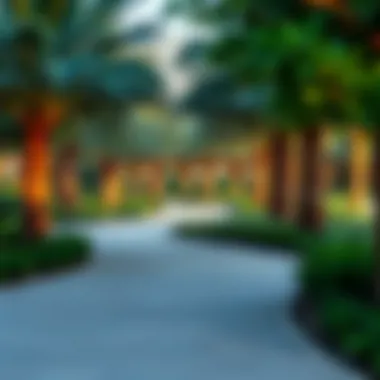

Exploring the topic of biodiversity brings another layer to the significance of the Gardens of Sheikh Mohammed bin Rashid. This space has not only been designed to showcase aesthetic appeal but also to serve as a sanctuary for local flora and fauna. An increased focus on native species reinforces the idea that landscaping can play a pivotal role in conservation efforts.
The gardens feature a carefully curated selection of plants that attract pollinators, such as bees and butterflies. This ecological interaction is vital, particularly in urban settings where natural habitats are rapidly diminishing. By promoting these species, the gardens aid in the support of local ecosystems and strengthen biodiversity in the area—an essential factor in maintaining ecological balance.
In addition, the gardens serve as an educational platform, enlightening visitors about the importance of preserving native species and ecosystems. Special programs align with this goal, promoting awareness of the delicate interplay between urbanization and nature.
"Integrating ecological practices in urban spaces like the Gardens of Sheikh Mohammed bin Rashid exemplifies how cities can act as stewards of the environment while serving their communities."
Through these initiatives, the gardens not only beautify the city but also foster a sense of responsibility towards maintaining biodiversity. The effort reflects an understanding that urban gardens can be dynamic ecosystems, essential for the health of the environment and the well-being of its inhabitants.
Recreational Opportunities
When we look at the Gardens of Sheikh Mohammed bin Rashid, it’s hard to miss the significant role they play in the recreational landscape of Dubai. Not just a feast for the eyes, these gardens offer a symphony of activities that lure locals and tourists alike. The combination of aesthetic beauty and functional use makes the gardens a vital component of Dubai’s urban recreational framework.
Landscaped Spaces for Community Engagement
In the realm of community engagement, the gardens stand tall, beckoning people from all walks of life. These landscaped spaces are designed with the intention of promoting interaction among visitors. Imagine a weekend where families come together, laughter echoing amidst carefully curated flower beds and lush greenery. The local community frequently utilizes open lawns for picnics, sports activities, or simply a casual stroll.
One might say that these gardens are the heart of the community. Their layouts often include dedicated zones for activities such as yoga classes, art workshops, and cultural performances. The versatility of these spaces ensures that there is something for everyone, be they families enjoying a day out, fitness enthusiasts engaging in sports, or children running amok on playgrounds sprinkled throughout the garden.
Moreover, the presence of benches and shaded areas allows for leisurely conversations, fostering a sense of connection among visitors. The gardens provide a canvas where community members can paint a mosaic of memories together. It’s more than just greenery; it’s a living, breathing testament to community spirit.
Event Hosting and Cultural Programs
Another vital aspect of the gardens is their capability to host events and cultural programs. With ample space to accommodate large gatherings, it’s common to find festivals, exhibitions, and cultural celebrations taking place within the garden’s confines. This aspect not just enriches the visitor experience but also solidifies Dubai’s reputation as a hub of cultural vibrancy.
The gardens often feature seasonal events that highlight local traditions and creativity. For instance, during the spring, one might find a festival celebrating local music, art, and culinary delights. Such events draw people together, allowing them to share, learn, and appreciate the diverse cultures that make up the fabric of Dubai.
Additionally, the management of the gardens often collaborates with cultural organizations to organize educational programs, from workshops on regional plant species to art installations that reflect the rich history of the UAE. In doing so, they become a platform for cultural exchange, bridging gaps between different communities.
"These gardens not only beautify the city but serve as a dynamic space for unity and creativity among its people."
To sum it up, the Gardens of Sheikh Mohammed bin Rashid do much more than provide a picturesque backdrop; they are a catalyst for recreational, social, and cultural experiences that enhance community life. This combination of landscape design and community involvement plays a crucial role in reinforcing the gardens’ significance within Dubai’s urban fabric, making it a valued asset for investors, homeowners, and visitors alike.
Role in Urban Development
The Gardens of Sheikh Mohammed bin Rashid stand as a pivotal point in understanding how green spaces can influence urban development in a bustling metropolis like Dubai. These gardens are not merely aesthetic enhancements; they serve multiple functions that contribute to the overall urban architecture of the city. The insertion of such expansive green areas into an urban environment not only beautifies it but also promotes a healthy, sustainable lifestyle for the community.
Impact on Residential Areas
Green spaces are known for boosting property values, and the gardens certainly illustrate this phenomenon. Residents living near the gardens enjoy a blend of nature and urban convenience. This interwoven approach influences housing demand. Properties with proximity to well-maintained gardens often attract families seeking leisurely spaces for children to play or for community gatherings.
- Increased Property Value: Homes in neighborhoods adjacent to the gardens have reported significant appreciation rates. Real estate agents often highlight the gardens when marketing properties to prospective buyers, asserting their importance as a key factor in making a location desirable.
- Family-Friendly Environment: With amenities such as walking trails, playgrounds, and picnic areas, the gardens offer a respite from urban chaos. An enriching family-oriented atmosphere fosters community interaction, leading to a strengthened sense of belonging among residents.
- Health Benefits: Access to green spaces contributes to mental and physical well-being. Research shows that living near parks can lower stress levels and promote outdoor activities, which can directly influence the health metrics of residents in the vicinity.
This transformation of these residential areas not only meets the needs of the current population but also aligns with the city’s broader objectives through smart urban planning.
Influence on Commercial Properties
The Gardens of Sheikh Mohammed bin Rashid also play a crucial role in shaping commercial real estate dynamics. Their presence influences business strategies, foot traffic, and overall commercial appeal within Dubai's fast-paced economy.
- Attraction for Businesses: The proximity of the gardens offers businesses an attractive setting for customers. Restaurants, cafes, and retail outlets see increased traffic due to their location near these scenic areas. Establishments that embrace outdoor seating options are particularly popular, providing patrons a uniquely pleasant dining experience.
- Economic Boost: An influx of visitors to the gardens often translates into heightened economic activity in adjacent commercial areas. Local businesses can benefit from this by promoting seasonal events that attract more visitors, effectively knitting commercial success into the fabric of the community.
- Brand Image Enhancement: Businesses located near the gardens often see their brand image positively impacted. Companies that prioritize environmental sustainability attract clientele who value green initiatives. This partnership between commercial success and environmental responsibility cultivates a positive urban landscape.
The synergy created by these gardens amplifies their influence, firmly marking them as a significant player in not just enhancing property appeal but also in driving the local economy forward without compromising the natural beauty of the surroundings.
Visitor Experience
The Gardens of Sheikh Mohammed bin Rashid are not just a patch of greenery; they offer a rich experience that connects local people and tourists alike to the natural and cultural fabric of Dubai. Understanding how visitors interact with these spaces is crucial for appreciating their significance and the positive impact they have on the community.
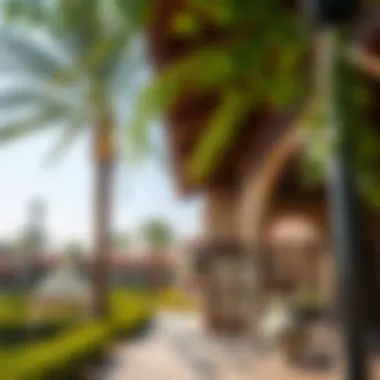

Accessibility and Connectivity
One of the standout features of the Gardens is their accessibility, making them open to visitors of all backgrounds. The design pays careful attention to accommodating both pedestrians and cyclists, ensuring that all can find a way to enjoy the beauty of the landscapes.
- Public Transport Links: The gardens are well-served by various modes of public transport. Nearby metro stations and bus stops are easily reachable, allowing for efficient travel across the city.
- Walkable Pathways: The various walking tracks within the gardens are designed to be user-friendly. Visitors can meander through beautifully designed pathways, which are lined with indigenous flora. This emphasizes not only accessibility but also an intimate connection with nature.
- Wheelchair Access: Special lanes and ramps have been included to ensure that those with mobility challenges are not left out. The aim is to make the gardens a gathering point for everyone in the community.
These connectivity features are more than mere conveniences; they reflect a dedication to inclusivity and the encouragement of diverse visitor interactions.
Guided Tours and Educational Programs
Another critical aspect of the visitor experience is the availability of guided tours and educational programs. These initiatives are designed to deepen the understanding of the gardens’ significance and enrich the overall experience.
- Guided Tours: Provided by knowledgeable local guides, these tours add a layer of context to the visitor experience. Each tour is tailored to highlight important design elements and cultural significance, ensuring that guests leave with much more than just a superficial view of the gardens. Visitors are often engaged with stories that inform them about the rich history and symbolism embedded in the garden spaces.
- Educational Workshops: The educational programs cater to schools and community groups, focusing on aspects like sustainability and environmental stewardship. These workshops aim to instill a sense of responsibility towards nature in younger generations. Attendees learn about local biodiversity and the various conservation efforts that the gardens support.
"The gardens serve as a living classroom, where the lessons of the past meet the aspirations for a sustainable future."
Having an immersive experience helps foster a culture of appreciation for both the gardens and their ecological offerings. This leaves visitors not only with memories but also with an enriched understanding of the world around them.
In sum, the visitor experience in the Gardens of Sheikh Mohammed bin Rashid is strategically crafted with accessibility and educational engagement at its core. This creates a multifaceted atmosphere that ultimately strengthens the gardens' role in community building and cultural education.
Challenges and Future Directions
The Gardens of Sheikh Mohammed bin Rashid sit at a crossroads of ecological demands and urban growth, making the exploration of challenges and avenues for future directions a pivotal aspect of understanding these landscapes. As urban areas expand at a breakneck pace, the gardens face multiple pressures that threaten their ecological integrity and sustainability. This section will delve into the environmental challenges they confront, as well as outline strategic planning for future developments.
Environmental Challenges Facing Urban Gardens
Urban gardens like those of Sheikh Mohammed bin Rashid are not merely decorative spaces; they also play a crucial role in improving the city's environmental quality. However, they encounter several significant challenges:
- Water scarcity: Dubai’s climate presents an ongoing struggle with limited freshwater resources. This makes sustainable irrigation essential yet complicated. The reliance on desalinated water can also be a heavy financial burden.
- Pollution: The dense population and heavy traffic contribute to air and soil pollution. As pollutants accumulate, maintaining plant health and ensuring the gardens’ beauty is complemented by ecological resilience becomes a challenging endeavor.
- Invasive species: Non-native plants may outcompete local species, leading to a loss of biodiversity. This raises concerns over the gardens' ecological balance, necessitating careful monitoring and management strategies.
- Climate change: Fluctuating weather patterns and increasing temperatures can adversely impact plant health and sustainability. Adaptation strategies must be implemented to optimize plant growth under these varying conditions.
"Urban gardens are a reflection of the city's priorities, showcasing a commitment to nature amidst concrete jungles."
Planning for Sustainable Future Developments
Looking ahead, the gardens can serve as vital models for sustainable urban landscapes. To mitigate the challenges aforementioned, a forward-thinking approach in planning is essential. Here are some strategic considerations:
- Smart irrigation systems: Integrating technologies like smart sensors can improve watering efficiency, minimizing waste. Such innovations will conserve water while sustaining the lushness of the gardens.
- Native plants selection: Using indigenous flora can bolster biodiversity and ensure the gardens remain resilient against local pests and diseases. This aligns with conservation efforts and reduces the need for chemical treatments.
- Community engagement: Involving local communities in the garden's upkeep not only fosters a sense of ownership but also educates residents about sustainable practices. This could include workshops on gardening, which would enrich community knowledge and connection to nature.
- Mitigation of urban heat: Green spaces can play a role in counteracting urban heat islands. Careful planning of vegetation layouts can enhance shade provision, thus improving not only the gardens’ environment but also the city’s climate resilience overall.
In summary, the challenges facing the Gardens of Sheikh Mohammed bin Rashid are significant but not insurmountable. By focusing on sustainable future developments, these gardens can thrive as vital green lungs for Dubai, striking a balance between nature and urban living.
Finale
The Gardens of Sheikh Mohammed bin Rashid hold a pivotal place within the very fabric of Dubai. As a culmination of design, culture, ecology, and community, these gardens extend beyond mere green spaces; they are living testaments to the aspirations of a modern city in harmony with nature. The discussion throughout this article underscores the various elements that make these gardens more than a recreational area.
Summary of Key Insights
In summarizing the key insights from this exploration, it is essential to highlight a few notable points:
- The gardens are not only a sanctuary for local flora but also a stage for cultural expressions through art installations that reflect the Emiratis' heritage.
- Sustainability is intricately woven into the gardens' design, propelling Dubai's commitment to environmental stewardship.
- The gardens play a significant role in urban development, influencing both residential and commercial sectors, enhancing property values and community engagement.
- Accessibility is a cardinal feature, allowing diverse demographics to experience the tranquility and educational opportunities the space provides.
These insights collectively outline the gardens as crucial players in advancing Dubai's urban narrative, where aesthetics meet practicality.
Final Thoughts on the Gardens' Role in Dubai's Identity
Dubai's identity is inextricably linked to its ambitious projects and innovative designs, but it's the greenery of the Gardens of Sheikh Mohammed bin Rashid that softens the bustling city's image. They symbolize the blend of tradition and modernity, where ancient cultural values coexist with contemporary aspirations.
The gardens serve as a reminder of the importance of nature in urban landscapes, urging city planners and residents alike to consider sustainable living. They not only beautify the city but also enrich the social fabric by offering a space for community interactions and cultural events.
This seamless integration of nature into Dubai's urban identity captures the essence of what it means to thrive in a desert metropolis while honoring the rich heritage that continues to shape the emirate's future.
"In every flower that blooms in these gardens, a piece of Dubai's story unfurls, intertwining the past with the present."
As we observe these dynamics at play, the Gardens of Sheikh Mohammed bin Rashid not only flourish in their botanical glory but also in their ability to inspire conversations about sustainability and community—a blueprint for other urban settings seeking harmony between nature and modernity.
